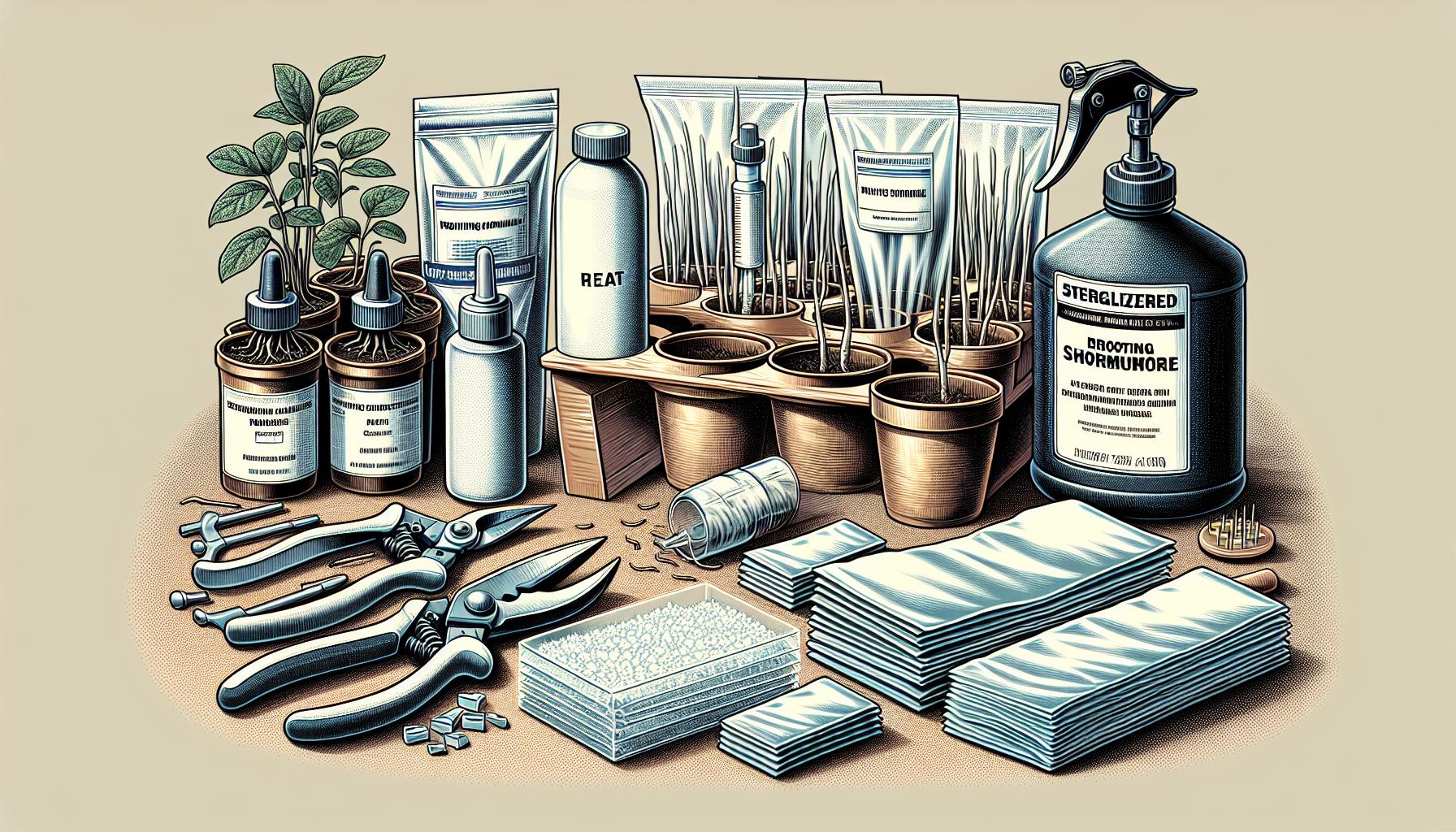
Propagating your Swiss cheese plant is a fantastic way to multiply the luscious, tropical vibes in your home. It’s simpler than you might think, and with the right tips, you’ll be on your way to creating new plants in no time.
Choosing the right time to propagate
When you’re ready to propagate your Swiss cheese plant, timing is key to ensuring the best chance of success. The optimal period for propagation is during the spring and early summer months. This is when the plant is in its active growth phase, making it more resilient and ready to establish new roots.
During this season, your plant’s metabolism is high, which means healing and root development happen more quickly. Factors like temperature and light are also on your side – the warmer weather and longer days provide the perfect environment for your cuttings to thrive.
Here’s what to keep in mind:
- Spring to Early Summer: Best for quick rooting and vibrant growth
- Warmth and Light: Essential for encouraging root development
- Avoid Winter: Shorter days and cooler temperatures slow growth
If you wait until fall or winter, the lower light levels and cooler temperatures can slow down the rooting process, making your Swiss cheese plant’s cuttings take longer to establish themselves. Remember, your cuttings will need all the strength they can muster to develop into healthy new plants. By choosing the right time, you’re giving them a significant head start.
Gathering the necessary materials

Before you can begin the propagation process, it’s essential to gather everything you’ll need to ensure your Swiss cheese plant cuttings have the best chance of taking root and growing effectively.
First and foremost, you’ll need a Sterile, Sharp Pair of Pruning Shears or Scissors. Sterilization is key to prevent the spread of disease to your cutting and the mother plant. You can sterilize your tool with alcohol or by flaming it briefly.
Rooting Hormone can significantly increase the likelihood of your cuttings taking root. Although not strictly necessary, it acts as a catalyst, encouraging faster root development and providing an antifungal environment.
You’ll also require a Suitable Propagation Medium. While water is the simplest medium, using a mix of peat and perlite or sand can offer a more stable environment for root growth. It’s also more akin to the medium the plant will eventually grow in, which can make the transition easier.
Clear Plastic Bags or a Propagation Chamber will create a humid environment which helps cuttings stay hydrated and healthy. Ensure they’re clean to reduce the risk of contamination.
Don’t forget Plant Pots or Containers with drainage holes. The size of the pot should accommodate the size of your cutting without being excessively large.
Finally, having Labels can be helpful if you’re propagating multiple cuttings at once. They’ll help you keep track of growth progress and any other specific details per plant.
With these materials at hand, you’re ready to take the next step in successfully propagating your Swiss cheese plant.
Selecting the perfect cuttings

When you’re ready to expand your collection of Swiss cheese plants through propagation, the cuttings you choose can make all the difference. Healthy parent plants are the key to success, so start by inspecting your plant for vigorous, disease-free growth.
Look for Stems With Nodes
Your cuttings need to have at least one node, as this is where new roots will sprout. Here’s what to focus on:
- Choose a section of stem about 4 to 6 inches long
- Ensure there are 2 to 3 healthy leaves present
- Identify a node — a small bump or budge in the stem
Assess the Overall Health
- The stem should be green and firm, not yellow or brown
- Leaves should be vibrant and free from spots or blemishes
Consider the Age of the Plant
- Mature plants are typically better donors as their stems are more resilient
- Younger plants can still provide cuttings but handle them with extra care
Timing Is Everything
- Spring and early summer are the best times to take cuttings
- Plants are in their active growth phase and more likely to root successfully
Once you’ve identified the ideal stem, use your sterilized pruning shears or scissors to make a clean cut just below a node. Applying rooting hormone to the cut end can further stimulate root development.
After taking your cuttings and treating them with rooting hormone, place them in your chosen propagation medium. This should be a moist, but not soggy, environment to encourage roots without risking rot.
Taking the time to select the right cuttings is an investment in your propagation success. With the proper cutting, the chances of growing a new, robust Swiss cheese plant increase significantly. Maintain optimal humidity by covering the cutting with a clear plastic bag or placing it in a propagation chamber, and soon, you’ll see signs of new growth. Remember to label your cuttings with the date and plant type to track their progress and ensure that you’re nurturing your new additions properly.
Preparing the cuttings for propagation

Once you’ve selected your ideal Swiss cheese plant cuttings, it’s crucial to prepare them properly for a successful propagation.
Trim the Cuttings: Begin by trimming the cuttings to the right size. A length of 4-6 inches with 2-3 nodes is optimal. Use a sharp, clean pair of scissors or a knife to make a clean cut just below a node, which is the point from where leaves and roots grow.
Remove Excess Leaves: To prevent excess moisture loss, remove any large leaves near the bottom of the cutting. This also encourages the cutting to focus its energy on root development rather than sustaining a lot of foliage.
- Healing Period: Allow the cuttings to callous over for a few hours to a day. This process seals the cut area and can help in reducing the risk of rot once planted.
Rooting Hormone Application: Although optional, applying a rooting hormone to the cut end can significantly enhance rooting success.
- Dip the cut end of the stem into the rooting hormone powder or liquid.
- Tap off any excess product to avoid hormone burn, which can damage the cutting.
Insert into Propagation Medium: Plant the hormoned end of the cutting into a moist propagation medium, such as potting soil, peat moss, or a water container. Make sure that at least one node, preferably two, is submerged or buried as roots will develop from these points.
- Stability Assurance: Use supports like sticks or stones, if necessary, to keep the cutting upright.
- Ideal Environment: Ensure the propagation area has consistent humidity and warmth but is not exposed to direct sunlight. Direct sun can dry out cuttings prematurely.
Watering Scheme: If using a soil medium, water lightly just to keep the soil moist but not soggy. With water propagation, change the water every few days to prevent bacteria build-up which can lead to rot.
Remember, patience is key. Roots may take several weeks to develop, and it’s important not to disturb the cuttings unduly during this time. Keep monitoring and adjusting environmental conditions to maintain the health of your cuttings as they establish new roots.
Creating the ideal propagation conditions

To successfully propagate Swiss cheese plants, you need to recreate the environment that they naturally thrive in. Humidity, temperature, and light are crucial factors in ensuring your Swiss cheese cutting develops into a healthy, mature plant.
Humidity Levels
Swiss cheese plants originate from tropical environments, so high humidity is essential for root formation. Aim to maintain a humidity level of around 60-70%. You can do this by:
- Placing a humidity tray filled with water and pebbles beneath your planting container.
- Using a humidifier in the room where you’re propagating the cuttings.
- Creating a microclimate by covering the cutting with a clear plastic bag or cloche to trap in moisture.
Temperature
Keep the temperature consistent, ideally between 18°C to 24°C (65°F to 75°F). Too much deviation from this range can significantly slow down or even halt the rooting process. If necessary, use a heat mat to provide a stable temperature base for your cuttings.
Lighting
While Swiss cheese plants prefer bright, indirect sunlight, avoid placing your cuttings in direct sunlight as it can damage them. Find a well-lit spot, such as near a window with a sheer curtain, to protect your plant while providing ample light.
Monitoring and Adjusting
Constantly monitor the conditions your cuttings are in and adjust as needed. Every plant is unique, and you might find that subtle changes in your home environment can make a big difference. Use a thermometer and hygrometer to track temperature and humidity and ensure they remain at optimal levels for rooting.
With the right conditions in place, your Swiss cheese plant cuttings are positioned for successful growth. Track the environment closely and prepare to watch your Swiss cheese plant flourish.
Caring for the newly propagated plants

Once your Swiss cheese plant cuttings have successfully taken root, your focus must shift to post-propagation care, which is vital for their continued growth and development. Light: Newly propagated Swiss cheese plants thrive in bright, indirect sunlight. Placing them too close to a direct light source can scorch their delicate leaves. Aim to provide your plants with at least 6-8 hours of filtered light daily for optimal growth.
Watering: Overwatering can spell disaster for young plants. Instead, water your new Swiss cheese plants when the top inch of the soil feels dry to the touch. This method prevents root rot and ensures the plants receive enough moisture without becoming waterlogged.
Feeding: Once your plants exhibit new growth, it’s time to start feeding. Use a balanced, water-soluble fertilizer every 4-6 weeks during the growing season. This regular feeding regime supports healthy foliage and robust stems.
Repotting: As your plants grow, their root system will eventually require more space. When you notice roots peeking through the drainage holes, upgrade to a pot that is 2-3 inches larger in diameter. This gives your Swiss cheese plant ample room to expand and flourish.
Remember, these young plants are still acclimating to their new environment. Regular monitoring allows you to respond quickly to any signs of distress, adjusting care routines as necessary to prevent issues before they escalate. Keep an eye out for common pests and diseases too, as prevention is always better than cure when it comes to plant health.
Conclusion
You’re now equipped to successfully propagate your Swiss cheese plant and ensure its thriving growth. Remember to provide your cuttings with the ideal lighting conditions and water them just right—when that top inch of soil is dry. With regular feeding during the growing season and attentive care, you’ll see your efforts pay off in lush, healthy growth. Keep an eye out for any signs of trouble and be ready to repot when the time comes. Your Swiss cheese plant’s journey from a simple cutting to a full, vibrant specimen is a rewarding experience. Happy planting!
Colin Macmillan is a seasoned entrepreneur and the CEO of Riverwood Landscape, a leading landscaping company based in Canada. He has been at the helm of the company since leaving high school, demonstrating his strong leadership skills and business acumen.
Colin’s expertise lies in various aspects of landscaping, including lawn care, interlocking, sod installation, and commercial maintenance. His hands-on approach and dedication to the craft have been instrumental in building Riverwood Landscape into a reputable brand.
One of his most notable achievements is the creation of a successful landscape franchise that services multiple locations. This accomplishment underscores his strategic thinking and ability to scale operations effectively.
Colin has also had the privilege of working with Guelph Hospital for landscaping and maintenance, a testament to the trust and reliability that his company has earned over the years.
His professional mission is to offer the best services and experiences for customers, a goal that he tirelessly pursues. Colin’s commitment to excellence and customer satisfaction continues to drive the growth and success of Riverwood Landscape.








